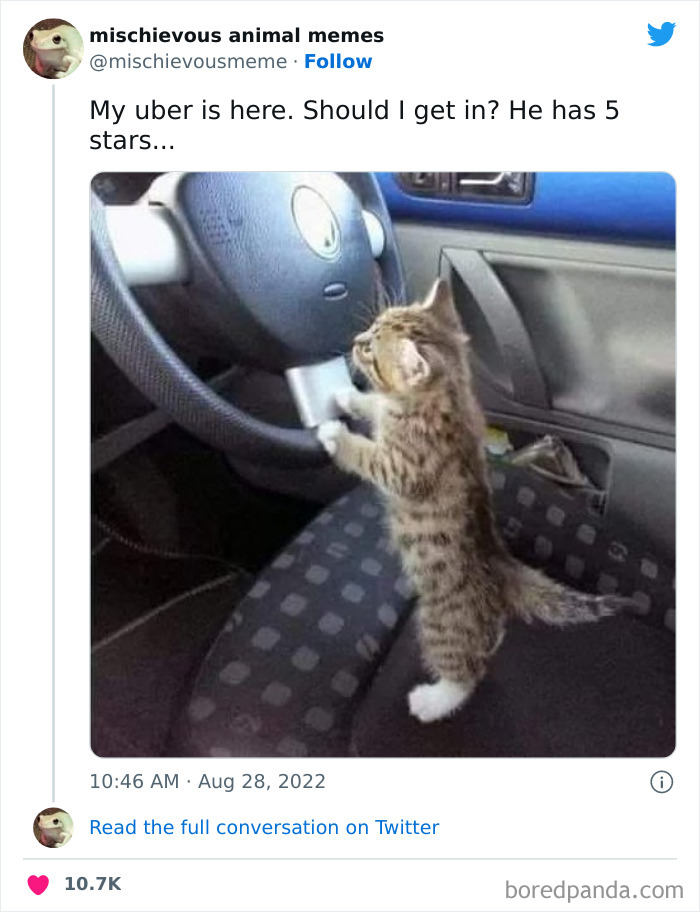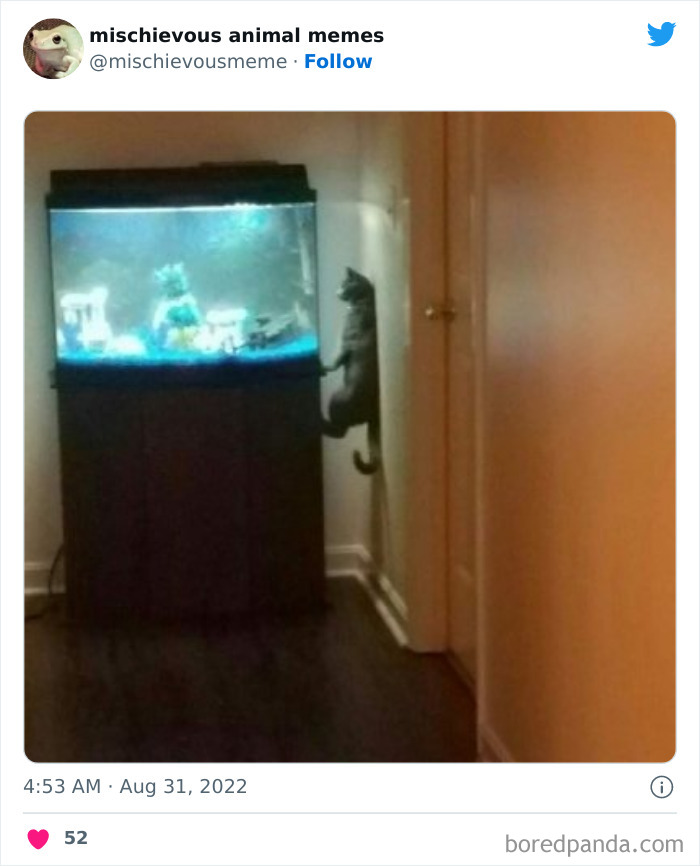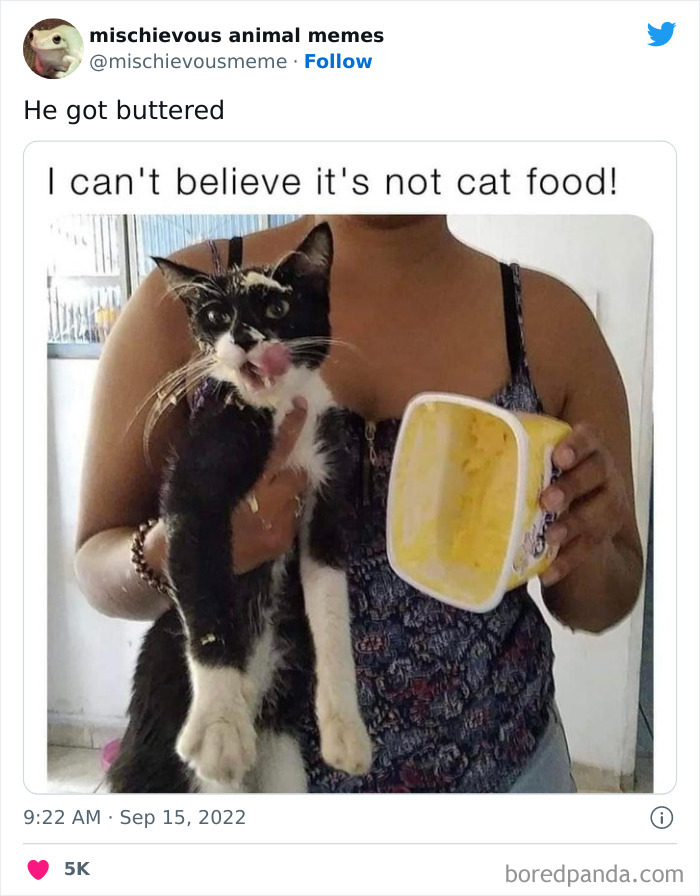
This Twitter Page Is Dedicated To Mischievous Animal Memes, Here Are 35 Of The Funniest Ones
The best cure for the Monday blues and a hard week at work and school is a total and unapologetic system overload with silliness and cuteness. And what better way to boost your mood, Pandas, than by showing you just how adorably mischievous our pets and animals in the wild might get.
From delightfully derpy to undeniably cool and beyond, the ‘Mischievous Animal Memes’ Twitter account posts funny animal pics that are so funny, you’ll probably want to share ‘em with your friends. We’ve collected the very best memes to remind you of just how fun life can be, as long as you’ve got a furry buddy by your side.
Check out the silliest memes below and don’t forget to upvote the ones that made you smile the widest as you scroll down, Pandas. Do you have any silly pics of your own pets that you’d love to share with everyone else? You can post them in the comment section at the very bottom of this list. Oh, and tell your cat/dog/raccoon we said hi!
This post may include affiliate links.
The friendly team at the PDSA, the UK’s leading vet charity, was kind enough to share some tips with Bored Panda on how owners can discipline their pets and correct overly mischievous behavior without being mean.
“Training using punishments such as shouting, making physical contact, or aversive devices like choke chains is bad for our pet’s mental well-being. This type of training doesn’t don’t provide effective long-lasting results – things that cause anxiety and fear are proven to make animals learn at a slower pace. Imagine how you would feel if someone was telling you off but you didn’t know what for. Your pet won’t understand why they are being punished, and may instead learn that people can’t be trusted, which can lead to behavioral problems,” PDSA Vet Lynne James explained to Bored Panda.
“The kindest and most effective method of training for any animal is reward-based training or positive reinforcement,” she said.
PDSA Vet Lynne explained that these effective training methods include rewarding your pet when they do what you want them to do (“so they will want to do it again!”) and ignoring or redirecting undesirable behaviors.
“Remember, many of the behaviors that we might want to change stem from our pets’ natural instincts, such as cats scratching furniture or killing wildlife, and dogs chewing our things. If this happens, rather than trying to stop the unwanted behaviors with punishment, try providing your pet with a more appropriate way to express the behavior. For example, playing chase and hunting games with your cat can reduce the amount of wildlife they kill, while appropriate scratching posts can stop them scratching your sofa,” the PDSA representative said.
“Likewise, chewing helps keep dogs’ jaws strong, their brains active, and their teeth clean, so it’s important to provide them with plenty of opportunity to do this with appropriate toys or chews. Punishment is unlikely to be effective, as it can just make them scared of you and they may start to hide their behavior by doing it when you are not there, rather than stopping. These tips are best used from an early age, but adult pets can learn too, though you’ll need to be patient—any reshaping of undesirable behaviors will need to be done over longer periods of time to see any results.”
I love this so much, it would be the only time I was happy to have my train delayed! No delay repay from me!
PDSA Vet Lynne shared some top tips to help you out with reward-based training:
- “Know what makes your pet tick! Some prefer treats, whereas others favor praise or a toy. If using treats, keep their weight in mind—use tiny pea-sized amounts of treats, and keep track of how much they are getting.
- Timing is everything. To make sure your pet links the behavior with the reward, it needs to be given during the behavior or within half a second afterward.
- Keep training sessions short. If they are too long, your pet will lose interest and may get frustrated.
- Stay focused and clear. Focus on training one thing at a time, and use short clear Instructions.
- Continuity is key. The whole household needs to be on board with training for it to work. Use the same commands, in the same way, with each person.”
The ‘Mischievous Animal Memes’ project is incredibly fresh. Created barely a couple of months ago, in August of 2022, it currently has a small following of just over 8k Twitter users. However, the pics are super cute and mega fun, so we expect to see a lot of growth in the future.
It’s not just the photos themselves that are simply spot-on. The captions help amplify the humor a ton as well. When you’ve got a very limited space with which to make your audience laugh, in a very limited amount of time, brevity becomes king. So you’ve got to adapt and go for punchy, witty captions that capture the energy of the pics you’re sharing in a heartbeat. If you manage to get that combination of sassiness and silliness down well, you can go very far in terms of social media popularity.
Love, care, and attention are absolutely vital when caring for a pet at home. However, the more you learn about animal behavior and the more you become aware of their needs, the more you can improve their quality of life.
For example, cat behavior specialist Ingrid Johnson, the founder of Fundamentally Feline, explained to Bored Panda during a recent in-depth interview that felines prefer having choices, instead of being forced to do something.
"Cats prefer options rather than forced change. Whenever we do things like abruptly change brands of cat litter or change their diet it is always best to offer choices rather than forcing them into things," the cat behaviorist explained to Bored Panda.
"Cats also prefer humans that allow the cats to dictate the interactions. They do not like to be smothered. Allow the cat to approach and ask for petting rather than forcing it on them," Ingrid, from Fundamentally Feline, said.
The feline expert noted that cats can definitely sense our moods through the tone of voice that we use. "Animals are very perceptive, not to mention they can smell the chemical changes in our bodies when we are hormonal, sad, angry, sick, etc.," she said.
"Many cats learn that a loud raised voice means bad news and they run to hide. It is ideal to try to minimize such tones in the home as we can be doing a lot to stress out all of our pets even if the discussion is not directed towards them in any way, it can still affect them."
One way that pet parents show their love for their beloved floofs is by giving them snacks or feeding them way too much. Though it can make your pet happy for a few moments, it can also lead to some serious health issues down the line. Small snacks quickly add up to extra weight gain. This, in turn, leads to very real, very dangerous health problems. So proper dieting and exercise are essential to give the animals you care for a long and happy life.
“Dogs suffering from obesity have a much greater risk of developing arthritis, high blood pressure, diabetes, and cancer. Studies also show that dogs with obesity live about 2.5 years less than those at a healthy weight,” Dr. Ernie Ward, the founder of the Association for Pet Obesity Prevention told Bored Panda earlier that obesity is the biggest health threat to dogs and cats.
“More recent research proves that overweight or dogs with obesity have a lower quality of life, as reported by their pet parents. To put it bluntly, the fact is that dogs with obesity aren't able to live and enjoy their best lives, and we must do better,” Dr. Ward was very direct that obesity is a huge issue.
“When people ask me if it's better for a dog or cat to have obesity, I tell them ‘neither.’ Obesity is a disease and, as a veterinarian, I swore an oath to prevent animal disease and suffering. My goal is to prevent pet obesity and I've spent the last twenty years researching and teaching nutrition and weight loss methods to committed veterinary professionals and concerned pet parents,” he said.
“For dogs and humans, the weight-loss equation is about 60% to 70% diet and 30% to 40% physical activity. For cats, a species with different physiology and metabolism, it's about 90% diet and only 10% exercise,” the vet explained the biological and metabolic differences between cats and dogs.
“The first step toward a healthier weight for your dog is to schedule an appointment with your veterinarian. They will first determine your dog's Body Condition Score (BCS), establish target weight loss goals and ideal weight, and calculate the number of calories you should feed each day,” Dr. Ward said that some dogs may simply need to eat fewer calories throughout the day… others, however, may need special therapeutic diets.
“Your veterinarian will also make sure there isn't an underlying medical condition or disease causing the weight gain and that it's safe to begin an exercise program. In general terms, a dog (and their pet parent) needs about 30 minutes of aerobic activity each day,” he said, suggesting that walking is probably the best way to get this exercise because it’s quick, easy, efficient, and accessible.
“I prefer it to most other exercises because that's what dogs were designed to do best and most naturally. Plus, it's free! When walking, be sure to use a walking harness and not a neck or choke collar to prevent injury to the trachea or windpipe region of the throat and neck,” he said.
So long as a vet-supervised weight loss program is uses, your doggo buddy can safely lose from 3% to 5% of its body mass each month. Younger, more active dogs may lose a little more. “The most important thing to do is to monitor the weight each month. If your dog isn't losing the appropriate amount of weight in three months, you need to change the strategy.”

 Dark Mode
Dark Mode 

 No fees, cancel anytime
No fees, cancel anytime 




















































































